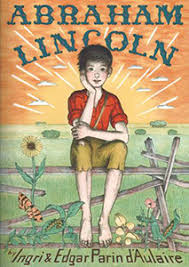Abraham Lincoln’s Caldecott
Listen to the Recess! Clip
| Author | Rita Smith |
| Air Date | 9/20/2005 |

Abraham Lincoln’s Caldecott Transcript
The 1940 winner of the Caldecott Award for most distinguished American picture book was a biography of Abraham Lincoln written and illustrated by Ingri and Edgar d’Aulaire. The book tells the life story of Lincoln, beginning with his birth in Kentucky and ending with a war-weary President a few days before his assassination. Although Ingri and Edgar were from Norway and Germany respectively, they immigrated to America in 1929 and became naturalized American citizens, which sparked their interest in figures of American history. They felt they could come to American themes and stories from a fresh, objective viewpoint, one that hadn’t been shaped into clichés from school textbooks or hampered by standard conceptions. The book generally received positive reviews when it came out. “[It] has a thrilling quality,” reviewer Irene Smith noted in 1939. She felt that Lincoln’s boyhood was portrayed with deep understanding and suggested children would be stirred by the sincerity of the pictures, with their noble simplicity, natural humor, and action.1 But not everyone was so enchanted even then. Ellen Buell of the New York Times Book Review wrote that “while some of the pictures are quite beguiling, others are downright ugly and the strong suggestion of primitive Scandinavian art strikes a false note” 2 given the American subject.
More recent criticism has been even more pointed and negative, suggesting that the text is over-romanticized and does not reflect the hardships and struggles that were part of Lincoln’s life. But it is the visual and textual treatment of the African American slaves that prompt the harshest criticism. Critic Bettye Latimer writes that “Blacks are illustrated as rigid figures, their immovable faces a dense, dark impenetrable mass pierced slightly by two white dots… and the entry of Black slaves into the story is abrupt …[T]heir condition is made to seem acceptable, not repulsive nor contradictory to…democracy.”3
In her Caldecott acceptance speech in June 1940, Ingri made mention of World War II and the fact that half the world was currently in flames. She hoped the book on Abraham Lincoln would be a “shining symbol of democracy, fairness and tolerance.” If that was the case in 1940, it is certainly not the case anymore. But Leonard Marcus suggests the book still has value as an historical artifact. “Time” he says “has left us aware of the shortcomings [of the d’Aulaire’s biography] while also reminding us that over time biographies themselves become historical documents, casting light not only on their subjects’ values and times, but also on those of their authors and readers.”4
Notes:
1 Quoted in Children’s Literature Review, p. 44.
2 Ibid., p. 45.
3 Ibid., p. 46.
4 Ibid., p. 38.
Sources:
Children’s Literature Review, Excerpts from Reviews, Criticism, and Commentary on Books for Children and Young People, Gerard J. Senick, Editor. Detroit: Gale Research, Inc., Volume 21, 1990, p. 32-46.
D’Aulaire, Ingri Parin and Edgar d’Aulaire, Abraham Lincoln, Garden City, New York: Doubleday * Company, 1939.
D’Aulaire, Ingri Parin and Edgar d’Aulaire, “Working Together on Books for Children,’ in The Horn Book, Volume XVI, Number 4, July/August, 1940, p. 247-225.